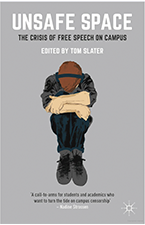
Tom Slater
Palgrave Macmillan UK, 2016; 134 pp;
ISBN: 978-1-137-58784-8
by Michael Dabrowski
No matter where you sit on the free speech debate, this short collection of chapters from a broad-spectrum of writers including the voices of academics, lawyers, campaigners, and activists from both the US and UK is worth reading. It outlines some of the challenges and regressions in the free speech battle on campus over the last 50 years. For free speech advocates, this short book draws a concise 50 year history of the decline of freedom and increase of censorships at academic institutions in the U.S and U.K. Topics exploring the impact on free speech of feminism, censorship of frat/lad culture, trigger warnings, abortion, terrorism, and the relations between Israel and Palestine are explored in individual chapters. The authors highlight the fine line between censorship in the hope of developing a more tolerant and inclusive society and censorship on campus with similar goals that stifle the underlying principles of free speech and debate in academic circles. “When we discuss campus censorship, it is our academic, intellectual and political future that is really at stake.”
The historical narrative that flows through this text traces the slow yet progressive erosion of free speech as safety moved from the physical to the social and emotional, and conflating harm with discomfort. The narrative also demonstrates how the lack of clear demarcation points allowed for a slow slide from curtailing one form of expression to creating a culture of censorship. It outlines how the academy and student body slowly embraced the external silencing of ideas. In the last chapter, Frank Furedi explores the shift of opposition to academic freedom from the external political and economic order to university administration, peers, and students. He rightly stresses that open debate is the cornerstone of university education and is essential to intellectual progress and the scientific method. He argues that students must demand a learning environment where they can grow and become resilient change agents.
The authors underline that it is one thing to criticize some forms of expression and ideas as inappropriate to reinforce, but when we declare that some ideas are too dangerous, hurtful, or threatening we cross over into censorship that threatens the foundational block of education, critical thinking. Merely saying that discussions of “sex, pregnancy, addiction, bullying, suicide, sizeism, ableism, homophobia, transphobia, slut-shaming, victim-blaming, alcohol, blood” require censoring does nothing to change the underlying behaviour in society. Greg Lukianoff argues that the ‘infantilising’ effects produced by trigger warnings and their corrosive effects on critical thinking for the entire peer group outweigh any benefits to individual students. Many of the authors view this as a profound crisis of mission because the university is a place where opinions are shared, debated, and judged. They argue that it is now becoming a place where ideas are feared and where discussion and debate are being shut down.
Physical risk-taking has been shown to help students cope with stressful situations, understand their limitations and mortality, and learn about the consequences of their actions while supporting the development of positive, pro-active attitudes (Gleave, 2008). Gleave demonstrates that avoiding risk during play can impair how we deal with everyday situations. Such behaviour can lead to a fear of thrill-seeking, and a lack of resilience leading to mental health issues. The benefits of risk extend to social and emotional risk-taking, providing opportunities to explore topics such as social justice, sustainability, and the coping skills required to function in a complex changing world (O’Gorman, 2019). In all these instances acceptable risk replaces the zero-harm approach. While research supports a shift towards risky play for youngsters, we are at the same time attempting to remove any chance for hazard or offence in the academy for fear of distress to students. Tom Slater closes off this text with a challenge to students and academics to embrace risk, and provides eight concrete steps that we can all take to push back against the silencing of free thought in order to create “places where any idea, no matter how offensive, challenging or disturbing, can be aired.”
What is perhaps lacking from this book is how we are to deal with the growing mental health issues on campus while considering the need for the freedom of expression. Perhaps another book will follow to address this balancing act.
__________________________________
Michael Dabrowski is an Academic Coordinator in the Faculty of Humanities and Social Sciences at Athabasca University, and past-president of the Canadian Network of Innovation in Education (CNIE-RCIÉ).